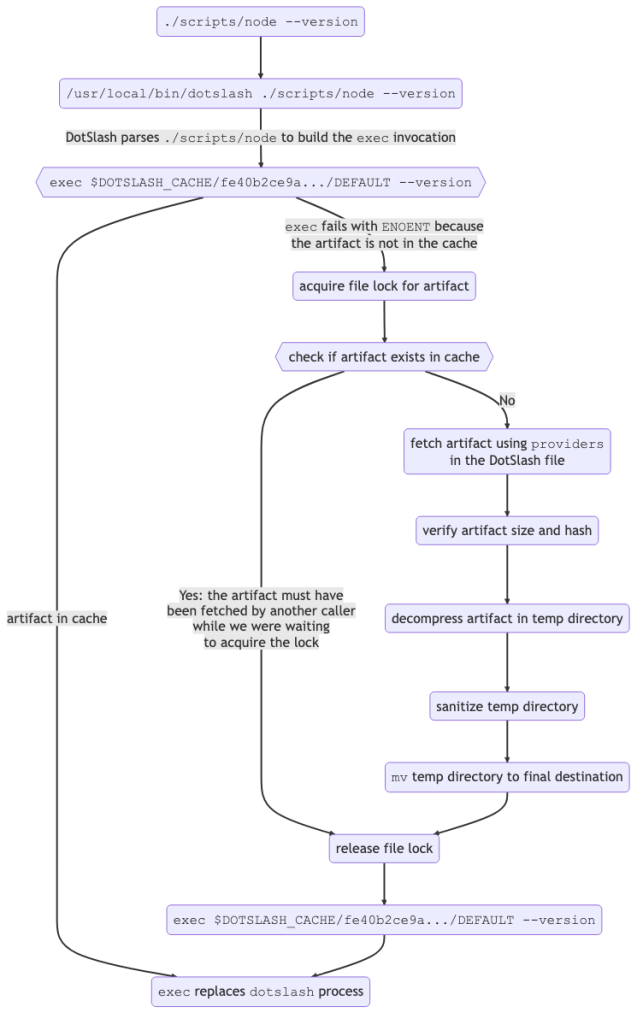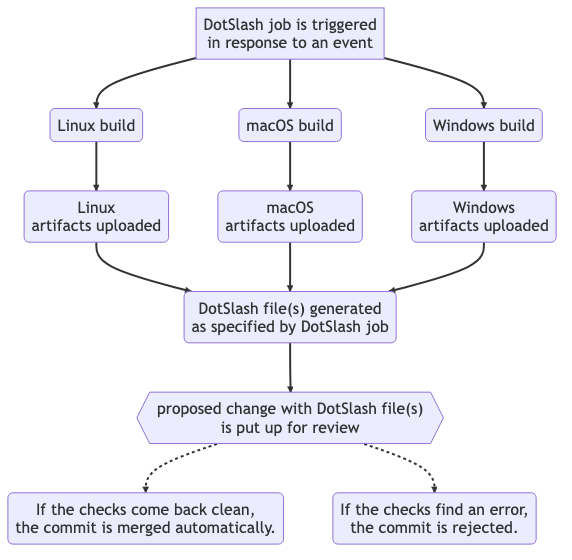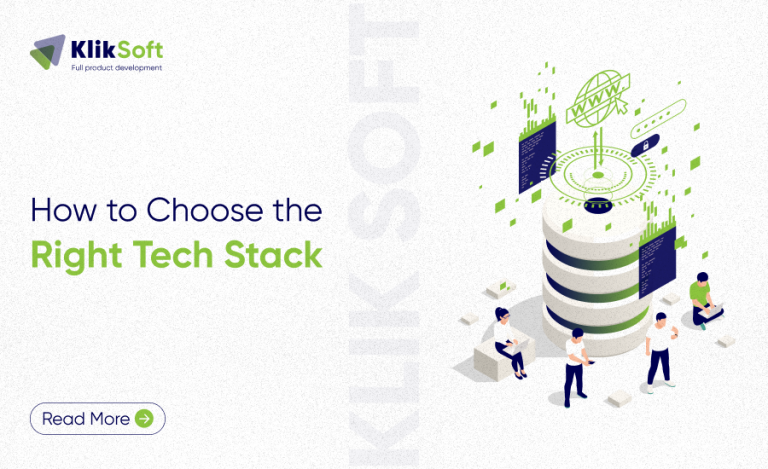- We’ve open sourced DotSlash, a instrument that makes giant executables out there in supply management with a negligible influence on repository measurement, thus avoiding I/O-heavy clone operations.
- With DotSlash, a set of platform-specific executables is changed with a single script containing descriptors for the supported platforms. DotSlash handles transparently fetching, decompressing, and verifying the suitable distant artifact for the present working system and CPU.
- At Meta, the overwhelming majority of DotSlash recordsdata are generated and dedicated to supply management by way of automation, so we’re additionally releasing a complementary GitHub Motion to assemble a comparable setup outdoors of Meta.
- DotSlash is written in Rust for efficiency and is cross-platform.
At Meta, now we have an enormous array of first-party and third-party command line instruments that should be out there throughout a various vary of developer environments. Reliably getting the suitable model of every instrument to the correct place is usually a difficult activity.
For instance, the supply code for a lot of of our first-party instruments lives alongside the initiatives that leverage them inside our large monorepo. For such instruments, the usual apply is to make use of buck2 run to construct and run executables from supply, as crucial. This has the benefit that instruments and the initiatives that use them could be up to date atomically in a single commit.
Whereas we use intensive caching and distant execution to offer our builders with quick builds, there’ll all the time be instances the place buck2 run goes to be significantly slower than operating the prebuilt binary instantly. Whereas we leverage a digital filesystem that reduces the drawbacks of checking giant binaries into supply management in comparison with a conventional bodily filesystem, there are nonetheless pathological instances which are finest averted by conserving such recordsdata out of the repository within the first place. (This apply additionally eliminates a big class of code provenance points.)
Additional, not every little thing we use is constructed from supply, nor do all of our instruments dwell in supply management. For instance, there may be the case of buck2 itself, which must be pre-built for builders and available on the $PATH for comfort. For core developer instruments like Buck2 and Sapling, we use a Chef recipe to deploy new variations, putting in them in /usr/native/bin (or someplace inside the acceptable %PATH% on Home windows) throughout quite a lot of developer environments.
Whereas this strategy is affordable for commonly-used executables, it’s not an incredible match for the lengthy tail of instruments. That’s, whereas it is perhaps handy to put in every little thing a developer may want in /usr/native/bin by default, this might simply add as much as tens or lots of of gigabytes of disk, little or no of which is able to find yourself being executed, in apply. In flip, this makes Chef runs dearer and liable to failure.
Introducing DotSlash
DotSlash makes an attempt to resolve most of the issues described within the earlier part. Whereas we don’t declare it’s a silver bullet, now we have discovered it to be the correct resolution for a lot of of our inside use instances. At Meta, DotSlash is executed lots of of tens of millions of occasions per day to ship a mixture of first-party and third-party instruments to end-user builders in addition to airtight construct environments.
The thought is pretty easy: we change the contents of a set of platform-specific, heavyweight executables with a single light-weight textual content file that may be learn by the dotslash command line instrument (which should be put in on the consumer’s $PATH). We name such a file a DotSlash file. It incorporates the data DotSlash must fetch and run the executable it replaces for the host platform. By conference, a DotSlash file maintains the title of the unique file somewhat than calling consideration to itself by way of a customized file extension. As a substitute, it aspires to be a clear wrapper for the unique executable. To that finish, a DotSlash file is required to start out with #!/usr/bin/env dotslash (even on Home windows) to assist keep this phantasm.
The next is a hypothetical DotSlash file named node that’s designed to run v18.19.0 of Node.js. Observe that customers throughout x86 Linux, x86 macOS, and ARM macOS can all run the similar DotSlash file, as DotSlash will deal with doing the work to pick the suitable executable for the host on which it’s being run. On this manner, DotSlash simplifies the work of cross-platform releases:
#!/usr/bin/env dotslash
// The information in a DotSlash file is encoded as a unfastened superset of JSON
// that permits for feedback and trailing commas.
{
"title": "node-v18.19.0",
"platforms": {
"linux-x86_64": {
"measurement": 11351600,
"hash": "blake3",
"digest": "7f83b1657ff1fc53b92dc18148a1d65dfc2d4b1fa3d677284addd200126d9069",
"format": "zst",
"suppliers": [
{
"uri": "https://example.com/bin/node/v18.19.0/node-linux.zst"
}
]
},
"macos-x86_64": {
"measurement": 11360000,
"hash": "blake3",
"digest": "94f217b7156fbcdc2285b1b216900b781a71dc19181d52e5477738af7d280f62",
"format": "zst",
"suppliers": [
{
"uri": "https://example.com/bin/node/v18.19.0/node-macos-x86_64.zst"
}
]
},
"macos-aarch64": {
"measurement": 11310000,
"hash": "sha256",
"digest": "eb3ede9ff516d6061d859ebdfa8e692255012bc91209946717c2c2e3204b6347",
"format": "zst",
"suppliers": [
{
"uri": "https://example.com/bin/node/v18.19.0/node-macos-aarch64.zst"
}
]
}
}
}
On this instance, the workflow DotSlash runs by when executing node seems to be like:

Due to how #! works on Mac and Linux, when a consumer runs ./node --version, the invocation successfully turns into dotslash ./node --version. DotSlash requires that its first argument is a file that begins with #!/usr/bin/env dotslash, as talked about above. As soon as it verifies the header, it makes use of a lenient JSON parser to learn the remainder of the file. DotSlash finds the entry within the "platforms" part that corresponds to the host it’s operating on.
DotSlash makes use of the data on this entry and hashes it to compute a corresponding file path (that doubles as a key) within the consumer’s native DotSlash cache. DotSlash makes an attempt to exec the corresponding file, changing argv0 with the trail to the DotSlash file and forwarding the remaining command line arguments (--version, on this instance) to the exec invocation.
If the goal executable is within the cache, the consumer instantly runs Node.js as initially meant. Within the occasion of a cache miss (indicated by exec failing with ENOENT), DotSlash makes use of the data from the DotSlash file to find out the URL it ought to use to fetch the artifact containing the executable in addition to the dimensions and digest data it ought to use to confirm the contents. If this succeeds, the verified artifact is atomically mv‘d into the suitable location within the DotSlash cache and the exec invocation is carried out once more. Observe that DotSlash makes use of advisory file locking to keep away from making duplicate requests even when DotSlash recordsdata requiring the identical artifact are run concurrently.
Observe that it is not uncommon to have a number of DotSlash recordsdata seek advice from the identical artifact, equivalent to a .tar.zst file, whereas every DotSlash file maps to a definite entry inside the archive. For instance, suppose node-v18.19.0-darwin-arm64.tar.gz is a compressed tar file that incorporates many entries, together with node , npm , and npx. The DotSlash file for node could be as follows:
#!/usr/bin/env dotslash
{
"title": "node-v18.19.0",
"platforms": {
"macos-aarch64": {
"measurement": 40660307,
"hash": "blake3",
"digest": "6e2ca33951e586e7670016dd9e503d028454bf9249d5ff556347c3d98c347c34",
// Observe the distinction from the earlier instance the place "format": "zst" has been
// changed with "format": "tar.gz", which specifies what kind of decompression
// logic to make use of in addition to the trail inside the decompressed archive to run when
// this DotSlash file is executed.
"format": "tar.gz",
// Assuming node-v18.19.0-darwin-arm64.tar.gz incorporates node, npm, and npx within the
// node-v18.19.0-darwin-arm64/bin/ folder inside the the archive, the next
// is the one line that has to vary within the DotSlash file that represents
// these different executables.
"path": "node-v18.19.0-darwin-arm64/bin/node",
"suppliers": [
{
"url": "https://nodejs.org/dist/v18.19.0/node-v18.19.0-darwin-arm64.tar.gz"
}
]
},
/* different platforms omitted for brevity */
}
}
As famous within the feedback, the one change within the DotSlash recordsdata for npm and npx could be the "path" entry. As a result of the artifact for all three DotSlash recordsdata could be the identical, whichever DotSlash file was run first would fetch the artifact and put it within the cache whereas all subsequent runs of any of the three DotSlash recordsdata would leverage the cached entry.
This method is commonly used to make sure that a set of complementary executables is launched collectively. Additional, as a result of the archive will likely be decompressed in its personal listing, it could additionally include useful resource recordsdata (or library recordsdata, equivalent to .dll recordsdata that must dwell alongside .exe recordsdata on Home windows) that will likely be unpacked utilizing the listing construction specified by the archive. This additionally makes DotSlash an excellent match for distributing executables that aren’t binaries, however bushes of script recordsdata, which is widespread for Node.js or Python.
Producing DotSlash recordsdata
At Meta, most DotSlash recordsdata are produced as a part of an automatic construct pipeline. Our steady integration (CI) system helps particular configuration for DotSlash jobs the place a consumer should specify:
- A set of builds to run (these can span a number of platforms).
- The ensuing generated artifacts to publish to an inside blobstore.
- The DotSlash recordsdata in supply management to replace with entries for the brand new artifacts.
- The situations underneath which the job must be triggered (that is analogous to workflow triggers on GitHub).
The results of such a job is a proposed change to the codebase containing the up to date DotSlash recordsdata. At Meta, we name such a change a “diff,” although on GitHub, this is called a pull request. Similar to an unusual human-authored diff at Meta, placing it up for assessment triggers quite a lot of jobs that embody linters, automated checks, and different instruments that present sign on the proposed change. For a DotSlash diff, if the entire indicators come again clear, the diff is robotically dedicated to the codebase with out additional human intervention.

The script we use to generate DotSlash recordsdata injects metadata concerning the construct job that makes it easy to hint the provenance of the underlying artifacts. The next is a hypothetical instance of a generated DotSlash file for the CodeCompose LSP constructed from supply at a particular commit in clang-opt mode. Observe the "metadata" entries within the DotSlash file will likely be ignored by the dotslash CLI, however we embody them as structured information to allow them to be parsed by different instruments to facilitate programmatic audits:
#!/usr/bin/env dotslash
// @generated SignedSource<<d8621e8ccbd7a595a3018e6a070be9c0>>
// https://yarnpkg.com/package deal?title=signedsource can be utilized to
// generate and confirm the above signature to flag tampering
// in generated code.
{
"title": "code-compose-lsp",
// Added by automation.
"metadata": {
"build-info": {
"job-repo": "fbsource",
"job-src": "dotslash/code-compose-lsp.star",
// It's thought of finest apply to construct the artifacts for
// all platforms from the identical commit inside a DotSlash file.
"commit": {
"repo": "fbsource",
"scm": "sapling",
"hash": "0f9e3d9e189bf393f7f9d0b6879361cd76fcdcd0",
"date": "2024-01-03 20:07:54 PST",
"timestamp": 1704341274
}
}
},
"platforms": {
"linux-x86_64": {
"measurement": 2740736,
"hash": "blake3",
"digest": "fc8a3ade56a97a6e73469ade1575e8f8e33fda99fbf6df429d555e480d6453d0",
"format": "zst",
"suppliers": [
{
"type": "meta-cas",
"key": "fc8a3ade56a97a6e73469ade1575e8f8e33fda99fbf6df429d555e480d6453d0:2740736"
}
]
// Added by automation.
"metadata": {
"build-command": [
"buck2",
"build",
"--config-file",
"//buildconfig/clang-opt",
"//codecompose/lsp/cli:code-compose-lsp"
]
}
},
// extra platforms...
}
}
With out DotSlash, a developer must run buck2 construct --config-file //buildconfig/clang-opt //codecompose/lsp/cli:code-compose-lsp to construct and run the LSP from supply, which could possibly be a gradual operation relying on the dimensions of the construct, the state of the construct cache, and so on. With DotSlash, the developer can run the optimized LSP as shortly as they’ll fetch and decompress it from the desired URL, which is probably going a lot quicker than doing a construct.
One other factor you will have seen about this instance is that the "key" will not be an unusual URL, however an identifier that occurs to be the concatenation of the BLAKE3 hash and the dimensions of the desired artifact. It is because "kind": "meta-cas" signifies that this artifact should be fetched by way of a customized supplier in DotSlash, which is specialised fetching logic constructed into DotSlash that has its personal identifier scheme. On this case, the artifact could be fetched from Meta’s in-house content-addressable storage (CAS) system, which makes use of the artifact hash+measurement as a key.
Whereas we don’t present the code for the meta-cas supplier within the open supply model of DotSlash, we do embody one customized supplier out-of-the-box past the default http supplier.
Utilizing DotSlash with GitHub releases
Whereas DotSlash is mostly helpful for fetching an executable from an arbitrary URL and operating it, now we have discovered the mixture of DotSlash and CI to be notably highly effective. To that finish, we embody customized tooling to facilitate producing DotSlash recordsdata for GitHub releases. To make sure DotSlash can fetch artifacts from personal GitHub repositories in addition to GitHub Enterprise cases, DotSlash features a customized supplier for GitHub releases that features an acceptable authentication token when fetching artifacts.
For instance, suppose you may have present workflows for constructing your launch artifacts and publish them by way of gh launch add. For simplicity, let’s assume these are named linux-release, macos-release, and windows-release. To create a single DotSlash file that features the artifacts from all three platforms you’d introduce a brand new GitHub Motion that leverages the workflow_run set off so it fires every time one among these launch workflows succeeds. (Observe that GitHub’s documentation states: “You may’t use workflow_run to chain collectively greater than three ranges of workflows,” so verify the depth of your workflow graph in case your workflow will not be firing.)
The .yml file to outline the brand new workflow would appear to be this:
title: Generate DotSlash File
on:
workflow_run:
# These should match the names of the workflows that publish
# artifacts to your GitHub Launch.
workflows: [linux-release, macos-release, windows-release]
sorts:
- accomplished
jobs:
create-dotslash-file:
title: Producing DotSlash File
runs-on: ubuntu-latest
if: ${{ github.occasion.workflow_run.conclusion == 'success' }}
steps:
- makes use of: fb/dotslash-publish-release@v1
env:
# That is crucial as a result of the motion makes use of
# `gh launch add` to publish the generated DotSlash file(s)
# as a part of the discharge.
GITHUB_TOKEN: ${{ secrets and techniques.GITHUB_TOKEN }}
with:
# Further file that lives in your repo that defines
# how your DotSlash file(s) must be generated.
config: .github/workflows/dotslash-config.json
# Tag for the discharge to to focus on.
tag: ${{ github.occasion.workflow_run.head_branch }}
As a result of inputs to GitHub Actions are restricted to string values, fb/dotslash-publish-release takes config, which is a path to a JSON file within the repo that helps a wealthy set of configuration choices for producing the DotSlash recordsdata. The opposite required enter is the ID of the discharge, which in GitHub, is outlined by a Git tag. When the motion is run, it would verify to see whether or not the entire artifacts specified within the config are current within the launch, and in that case, will generate the suitable DotSlash recordsdata and add them to the discharge.
For instance, take into account an open supply venture like Hermes the place a launch consists of quite a lot of platform-specific .tar.gz recordsdata, every containing a handful of executables (hermes, hdb, and so on.). To create a separate a person DotSlash file for every executable, the JSON configuration for the motion could be:
{
"outputs": {
"hermes": {
"platforms": {
"macos-x86_64": {
"regex": "^hermes-cli-darwin-",
"path": "hermes"
},
"macos-aarch64": {
"regex": "^hermes-cli-darwin-",
"path": "hermes"
},
"linux-x86_64": {
"regex": "^hermes-cli-linux-",
"path": "hermes"
},
"windows-x86_64": {
"regex": "^hermes-cli-windows-",
"path": "hermes.exe"
}
}
},
"hdb": {
"platforms": {
"macos-x86_64": {
"regex": "^hermes-cli-darwin-",
"path": "hdb"
},
"macos-aarch64": {
"regex": "^hermes-cli-darwin-",
"path": "hdb"
},
"linux-x86_64": {
"regex": "^hermes-cli-linux-",
"path": "hdb"
},
"windows-x86_64": {
"regex": "^hermes-cli-windows-",
"path": "hdb.exe"
}
}
},
// Further entries for hvm, hbcdump, and hermesc...
}
}'Every entry in "outputs" corresponds to the title of a DotSlash file that will likely be added to the discharge. The "platforms" for every entry defines the "platforms" that must be current within the generated DotSlash file. The motion makes use of the "regex" to determine the file within the GitHub launch that must be used because the backing artifact for the entry. Assuming the artifact is an “archive” of some kind (.tar.gz, .tar.zst, and so on.), the "path" signifies the trail inside the archive that the DotSlash file ought to run.
On this specific case, Hermes doesn’t present an ARM-specific binary for macOS, so the "macos-aarch64" entry is identical because the "macos-x86_64"one. Although if that modifications sooner or later, a easy replace to "regex" to differentiate the 2 binaries is all that’s wanted.
Observe that the motion will take accountability for computing the digest for every binary. On this instance, the ensuing DotSlash file for hermes could be:
#!/usr/bin/env dotslash
{
"title": "hermes",
"platforms": {
"linux-x86_64": {
"measurement": 47099598,
"hash": "blake3",
"digest": "8d2c1bcefc2ce6e278167495810c2437e8050780ebb4da567811f1d754ad198c",
"format": "tar.gz",
"path": "hermes",
"suppliers": [
{
"url": "https://github.com/facebook/hermes/releases/download/v0.12.0/hermes-cli-linux-v0.12.0.tar.gz"
},
{
"type": "github-release",
"repo": "facebook/hermes",
"tag": "v0.12.0",
"name": "hermes-cli-linux-v0.12.0.tar.gz"
}
],
},
// extra platforms...
}
}
Observe that there are two entries within the "suppliers" part for the Linux artifact. When DotSlash fetches an artifact, it would strive the suppliers so as till one succeeds. No matter which supplier is used, the downloaded binary will likely be verified towards the desired "hash", "digest", and "measurement" values.
On this case, the primary supplier is an unusual, public URL that may be fetched utilizing curl --location, however the second is an instance of a customized supplier mentioned earlier. The "kind": "github-release" line signifies that the GitHub supplier for DotSlash must be used, which shells out to the GitHub CLI (gh, which should be put in individually from DotSlash) to fetch the artifact as an alternative of curl. As a result of fb/hermes is a public GitHub repository, the primary supplier must be adequate right here. Nevertheless, if the repository have been personal and the fetch required authentication, we’d count on the primary supplier to fail and DotSlash would fallback to the GitHub supplier. Assuming the consumer had run gh auth login upfront to configure credentials for the desired repo, DotSlash would have the ability to fetch the artifact utilizing gh launch obtain.
By publishing DotSlash recordsdata as a part of GitHub releases, customers can copy them to their very own repositories to “vendor in” a particular model of your instrument with minimal impact on their repository measurement, no matter how giant your releases is perhaps.
Strive DotSlash At present
Go to the DotSlash website for extra in-depth documentation and technical particulars. The positioning consists of directions on Putting in DotSlash so you can begin enjoying with it firsthand.
We additionally encourage you to try the DotSlash supply code and supply suggestions by way of GitHub points. We sit up for listening to from you!














+ There are no comments
Add yours